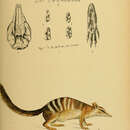Biology
provided by Arkive
Unlike most marsupials the numbat is active during the day, reflecting the behaviour patterns of termites, spending most of its active hours searching for food (2) (5). It is the only marsupial that strictly feeds on social insects, and consumes 20,000 per day, the equivalent to ten percent of its body weight (4). The numbat walks with its nose to the ground, sniffing and turning over small pieces of wood in search of shallow underground termite galleries (5). On finding a gallery it squats on its hind legs and digs rapidly with its clawed forefeet, licking up the termites with its long, thin tongue (4) (5). Some ants are also eaten, but research shows that most are predatory ants that rush in when numbats uncover a termite nest, indicating that they are lapped up accidentally with the termites, rendering its other name, the banded anteater, some-what misleading (6).
At night, numbats shelter in hollow logs that are too narrow for its predators, such as foxes, to enter. Should the numbat feel threatened, it turns its rump, which is extremely thick-skinned, to plug the hole and protect itself (4). It is a solitary animal for most of the year, occupying a home range of up to 370 acres, though in the summer before the breeding season a male will roam long distances outside its home range in search of a female (4) (5). During the cooler months, a male and a female may share the same home range, but they are rarely seen together (5). The female gives birth to four young between January and May, which attach themselves to her four nipples, as she does not have a pouch like other marsupials (5). The female does, however, have longer underbelly hairs to keep the young warm and protected (2). In July or August, the cooler months in Australia, the female deposits her young in a burrow measuring one to two metres long, leaving them to forage during the day and returning to suckle them at night. By October the young are half grown and by the summer months of December they disperse (5).
Conservation
provided by Arkive
The numbat is Western Australia's mammal emblem, a status which gives it widespread recognition and may well have saved it from extinction (4). Following the numbat's decline, this species has been listed as Vulnerable on the IUCN Red List (1), and Vulnerable on the Environment Protection and Biodiversity Conservation Act 1999 (EPBC Act) (3). Active intervention by the Australian Department of Environment and Conservation (DEC) has fortunately improved the numbat's chances of survival. DEC has implemented fox control in the areas where numbats are found, and is establishing new populations in various nature reserves and forests (5). Conservation programs are also re-introducing the numbat to areas from which they have disappeared, and are radio-tracking individuals to monitor their fate (8). Regular fox baiting is also carried out at Perup, Dryandra and at re-introduction sites and numbats are currently being bred for release at Perth Zoo (4) (7). The numbat's habitat is said to be secure at present, though this species will certainly need constant protection and continued re-introductions in order to recover (5) (8).
Description
provided by Arkive
The numbat is a small carnivorous marsupial from Australia, and the only member of the family Myrmecobiidae (2). It is a specialised termite-eater and is easily recognised by its slender, graceful body and short, stiff hair which is reddish-brown with black and white stripes across its back and rump (2). This marsupial has a long, hairy tail, which is often erected to give a bottle-brush appearance (2). Its snout is narrow and pointed, allowing it to get its tongue into narrow crevices, and it has a striking white-bordered dark stripe through each eye (4) (5). Males, females and juveniles are all similar in appearance. Indeed, it is difficult to mistake the numbat for anything else because of its distinctive appearance and because the numbat is the only Australian mammal that is solely active during the day (4).
Habitat
provided by Arkive
Inhabits eucalyptus forest and woodland, in areas particularly dominated by wandoo (Eucalyptus wandoo) or jarrah (Eucalyptus marginata) trees, though it was previously also found in areas of mulga (Acacia aneura) woodland (2). Semi-arid areas with these vegetation types provide the numbat with fallen hollow logs and branches for shelter, as well as food and support for termites that the numbat feeds on (2).
Range
provided by Arkive
The numbat was once widespread in Australia, and at the time of European settlement it was found in southern semi-arid and arid Australia and across much of the southern half of Western Australia (2). However, this species only survived in two remnant populations at Perup and Dryandra, in the south west of Western Australia. There are now also six self-sustaining re-introduced populations: four in Western Australia and one each in South Australia and New South Wales (2).
Status
provided by Arkive
Classified as Endangered (EN) on the IUCN Red List (1), and Vulnerable under the EPBC Act 1999 (3).
Threats
provided by Arkive
The numbat's populations have dramatically suffered from predation by introduced mammals such as the cat and red fox (Vulpes vulpes) (4) (7), and the clearing of the land for agriculture. This removes dead and fallen trees which numbats need for shelter and termites need for resources (4). Another factor could be the suppression of Aboriginal fire regimes, after the movement of Aboriginal people away from their traditional lands following the European settlement of Australia. Aboriginal fires were small and controlled, allowing regeneration each year and reducing the incidence of larger bush fires in the hot summer. Now these large bush fires are a greater threat and more widespread, causing extensive damage to the numbats' habitat, shelter and food sources (4) (6).

